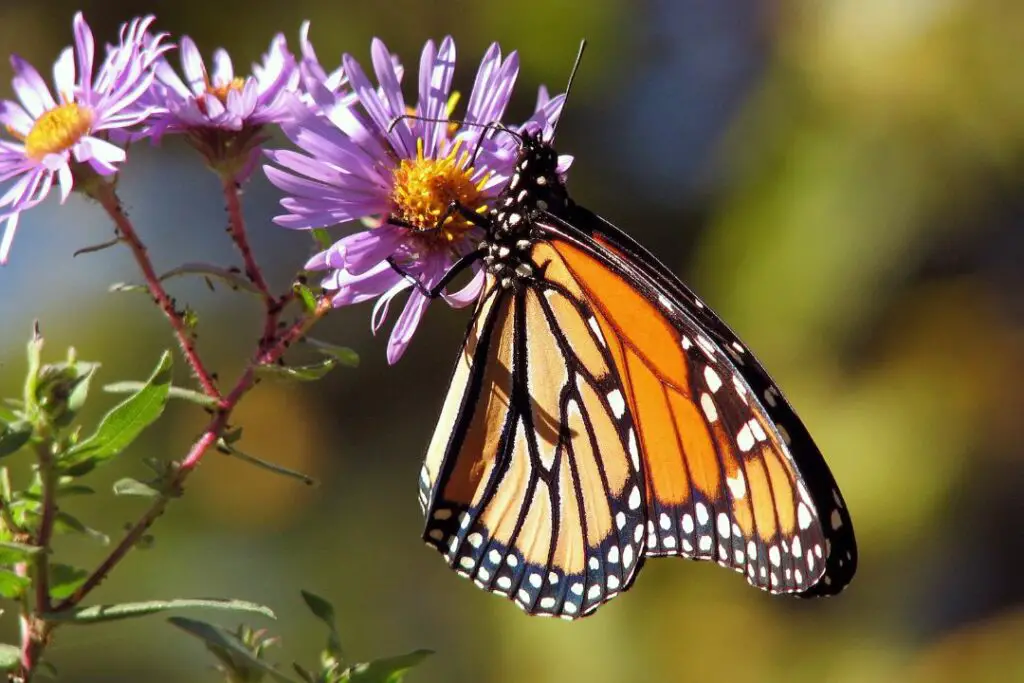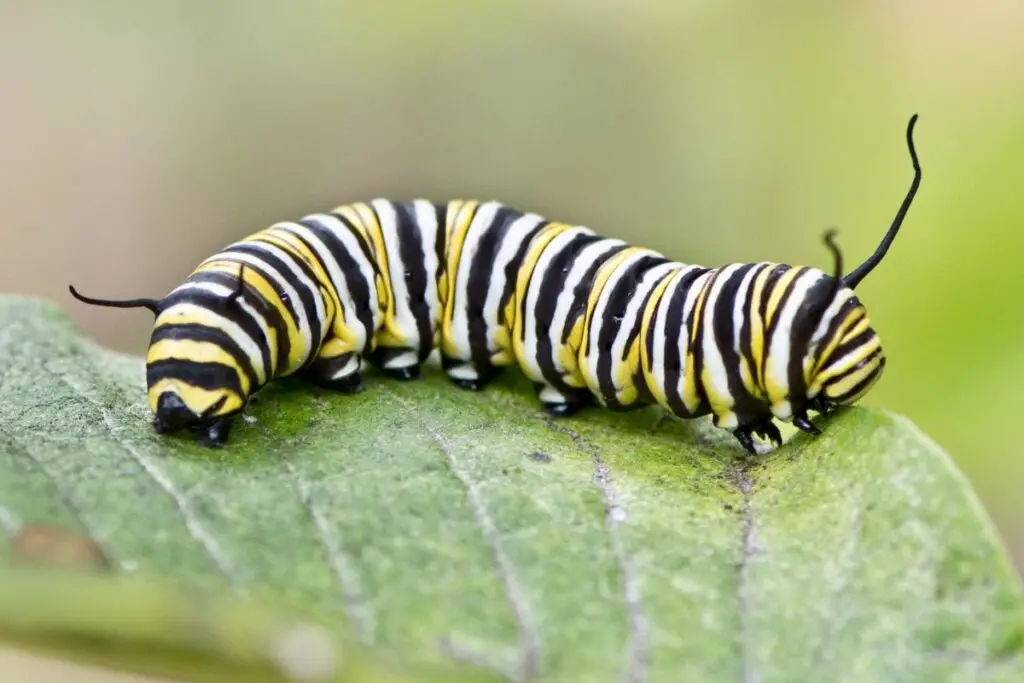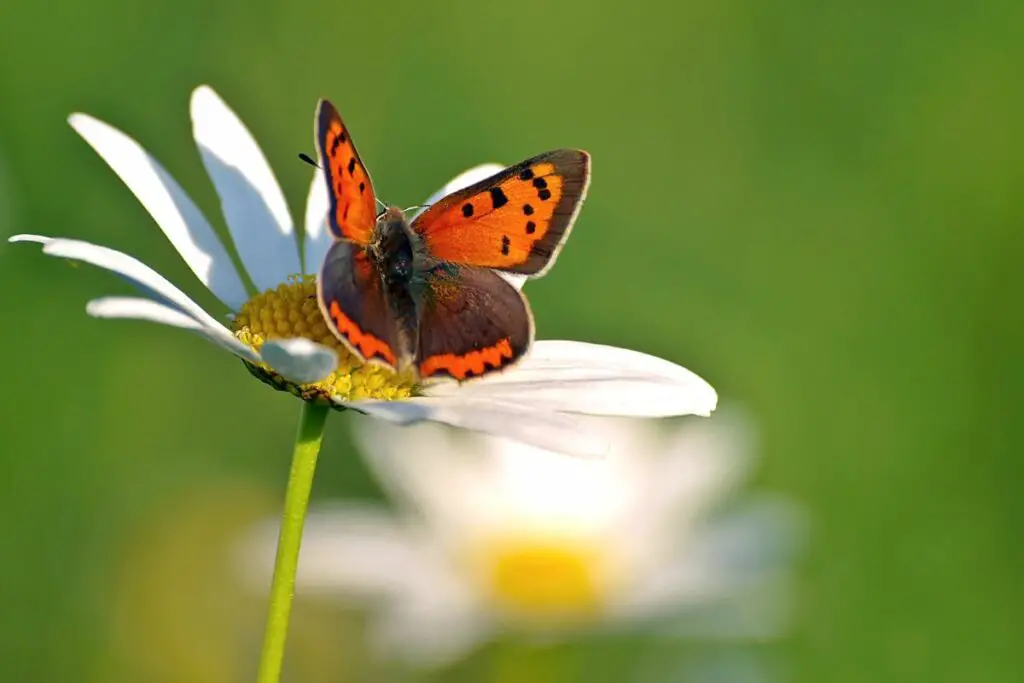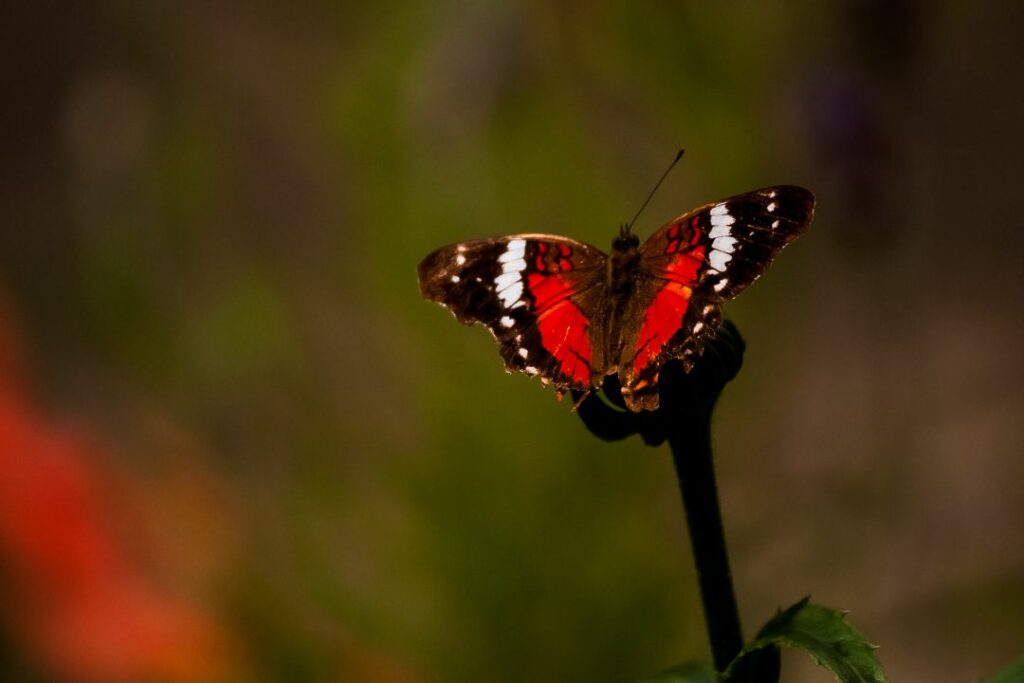Last updated on December 14th, 2023 at 04:56 pm
Have you ever wondered what those happily fluttering butterflies are up to in your backyard or garden? Turns out they spend most of their day on the hunt for food.
From the nectar of the most exotic blossoms to something as odd as rotting fruit, the butterfly’s diet is more like a culinary adventure than you might have guessed.
Intrigued? Well, keep on reading. We’re about to open the book of secrets on the butterfly diet and its journey packed with surprises.
So, ready to flit from flower to flower in search of butterfly food? 🦋 Let’s dive in.
The Basics of Butterfly Nutrition
Before we dive into the nitty-gritty details of a butterfly’s dietary extravaganza, let’s kick off with the basics.
Think of this as your Butterfly Diet 101—a quick overview to get you up to speed for what’s to come.
*Additional reading – Don’t miss our guide on bees’ diets and what they eat on the daily!
The role of nectar in a butterfly’s diet
If butterflies had a food pyramid, nectar would sit right at the base. It’s their go-to and provides them with the essential sugars to fuel their colourful flights.
And it’s this same sweet liquid that flowers produce that makes butterflies and bees such great pollinators. When a butterfly feeds on nectar, some surrounding pollen rubs off onto their body.
When they visit the next flower, they’ll act like a matchmaker, effectively transporting pollen from one flower to another.
Other sources of food
You know those cute pictures of a group of butterflies hanging out in a puddle? That’s not a butterfly pool party; it’s what’s known as “puddle feeding.” They suck up the muddy water to get salts and minerals.
Next up on the menu is rotting fruit. It’s a perfect energy boost, packed with sugars and nutrients.
And when nature isn’t providing, butterflies get crafty. They’ll slurp honeydew from aphids, enjoy the sweet juice from fruits, and even go for sugary human-made alternatives like a forgotten slice of orange on a picnic table.
Have you ever wondered if butterflies poo like we do? Find out in our short read, do butterflies poop?
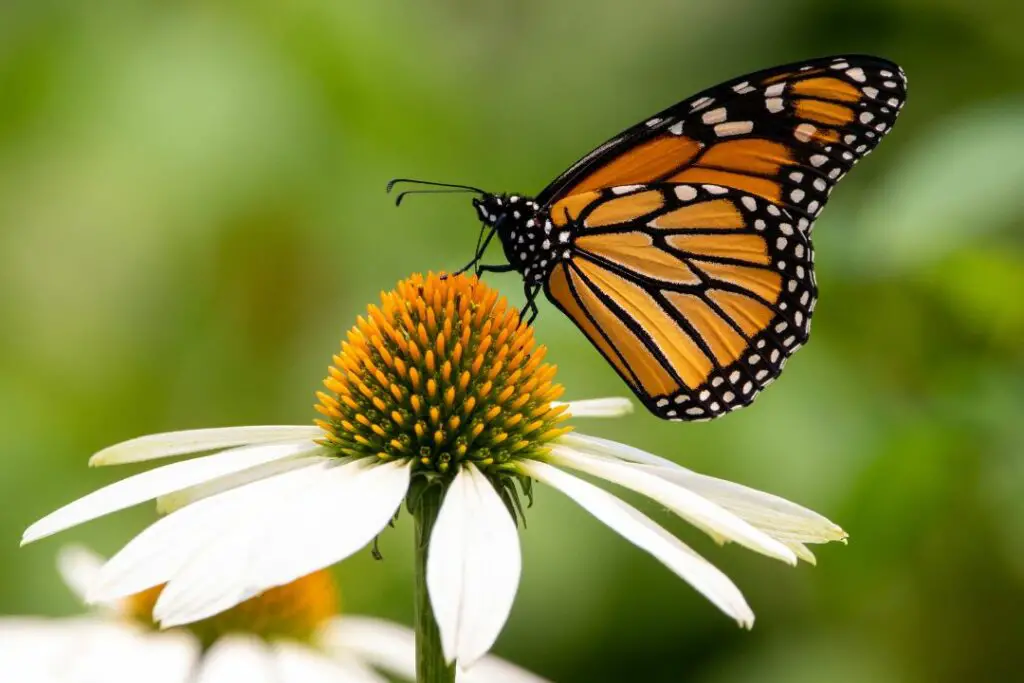
The Anatomy Of Feeding
Time to geek out a bit. The proboscis. It sounds like something from a sci-fi movie, right? But trust us, you’ll sound like a bonafide entomologist once you get the hang of this word.
And not just that—you’ll understand why it’s the butterfly’s Swiss Army knife of feeding.
How butterflies use their proboscis to drink
Imagine you had a tube built into your body that unfurled whenever you wanted a sip of something delicious. That’s a butterfly’s proboscis. This long, straw-like tube is usually coiled up and hidden but unrolls during snack time.
It works like a hydraulic system. It uncoils using a combo of muscle movement and hemolymph (insect blood) pressure.
Once extended, the proboscis acts like a straw, allowing the butterfly to suck up nectar or other liquids. It’s a fantastic feat of engineering, fine-tuned by thousands of years of evolution.
But it’s not just for flowers
The genius isn’t just in its design; it’s also in its versatility. This isn’t just a one-size-fits-all kind of appendage.
- Curl: It can curl to fit into tricky, deep blossoms.
- Poke: Need to penetrate a tough, rotting fruit? The proboscis can do that.
- Suck: From nectar to muddy puddles, it can suck up all sorts of liquid sustenance.
It’s almost like having a variety of kitchen utensils, from a spoon to a fork to a knife, all rolled into one. Whether they’re sipping nectar from flowers, absorbing salts and minerals from muddy puddles, or going gourmet on rotting fruit, butterflies use their proboscis like a pro.
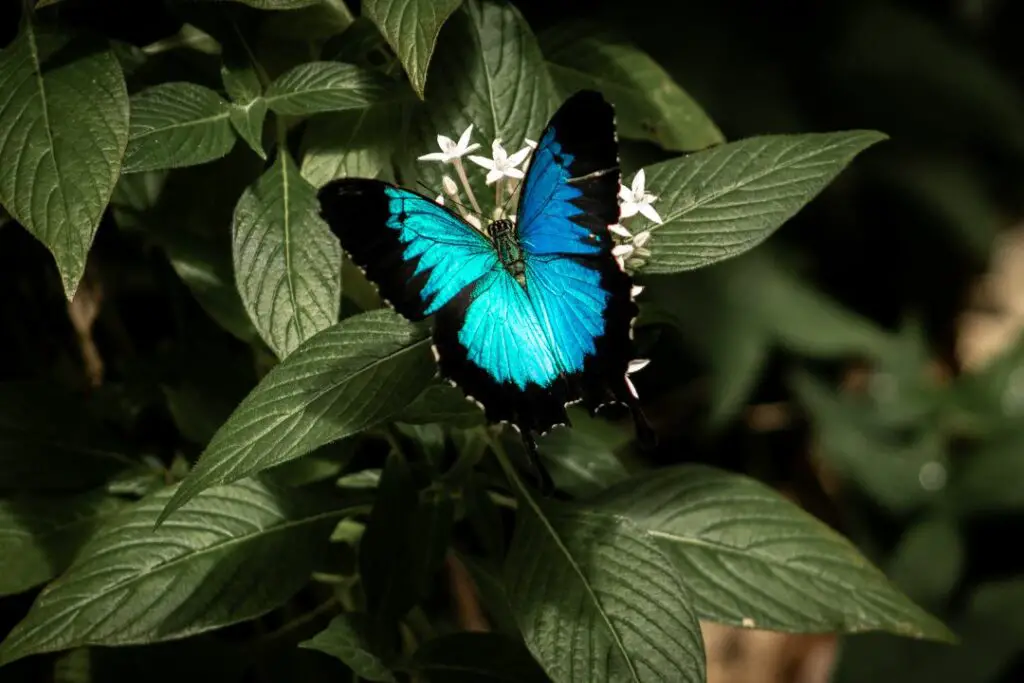
Perfect Plants For Butterflies To Eat
Green-thumbed readers now’s your time to shine. Now, we get to the part where your garden becomes the hottest butterfly diner in town.
If you’re all about growing nectar-rich plants and insects in your garden, why not add butterflies? The plants and flowers we’re about to discuss aren’t just eye candy; they’re natural butterfly magnets.
Buddleia (the butterfly bush)
Imagine an irresistible plant like the butterfly version of a Michelin-star restaurant. Yep, Buddleia is that plant.
So, what’s the magic trick? Buddleia has conical, nectar-rich blossoms that are easy for butterflies to perch on and feed from. The vibrant colours, from purple to pink to white, act like neon signs saying, “Open for Feeding!”
Plus, the plant emits a mild, sweet fragrance that acts like a siren song for butterflies. It’s no wonder they flock to it on mass.
Other butterfly-friendly options
Butterflies are gourmets with a broad palate, and Buddleia isn’t the only dish on the menu. Let’s glance at a buffet of other plants that attract these winged wonders.
| Plant Name | Why Butterflies Love It | Additional Benefits |
|---|---|---|
| Parsley | Rich in essential nutrients | Host plant for caterpillars |
| Lantana | High nectar content | Colourful and fragrant |
| Milkweed | Nectar and host plant | Crucial for monarch butterflies |
| Fennel | Feeding and laying eggs | It also attracts beneficial insects |
| Orange | Sweet, sugary nectar | It also attracts bees |
Whether it’s the lush, nutrient-rich leaves of parsley or the nectar-packed blooms of Lantana, these plants offer nourishment and, often, a place for butterflies to lay their eggs.
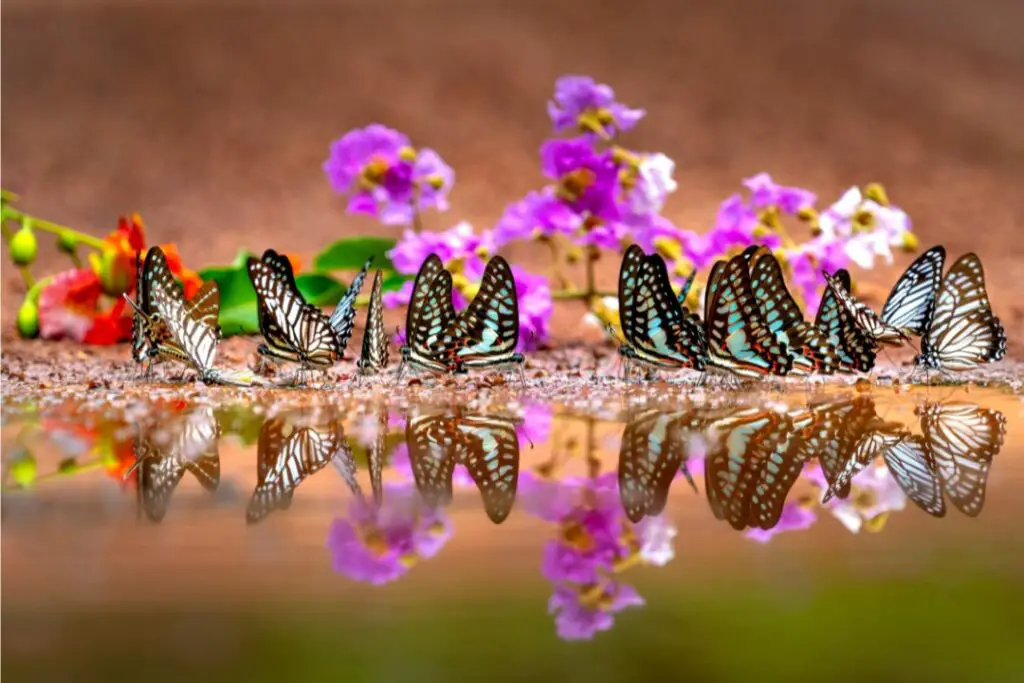
The Surprising Diet of Specific Butterfly Species
When you think butterflies are all figured out, they toss a curveball. Not all butterflies are sipping nectar and frolicking in fields of flowers.
Some of their diets will make you do a double-take. Yep, we’re diving into the oddball eating habits of specific butterfly species.
The painted lady
Ah, the Painted Lady. This social butterfly (pun intended!) isn’t too picky, but give it a thistle, and it’s love at first sight.
You’d think they’d go for the rose bushes or perhaps the more exotic lantana, but nope. Thistle, often considered a weed, is a firm favourite.
But don’t let that fool you; these butterflies will eat from various other plants, including those in your butterfly-friendly garden.
The carnivorous feeder
Hold onto your hats! The Harvester Butterfly is like the lion of the butterfly kingdom. Why? It’s carnivorous, and flowers are not on the menu.
If you’ve got an aphid problem, the Harvester Butterfly might be your new best friend. While most butterflies look for plants to feed on, the Harvester scopes out colonies of woolly aphids.
Woolly aphids provide amino acids, the building blocks of life. We’re talking about essential nutrients that help the Harvester thrive. It’s a circle of life thing but with less singing and more aphid-eating.
So whether they’re nectar-sippers or bug-hunters, butterflies are full of surprises.
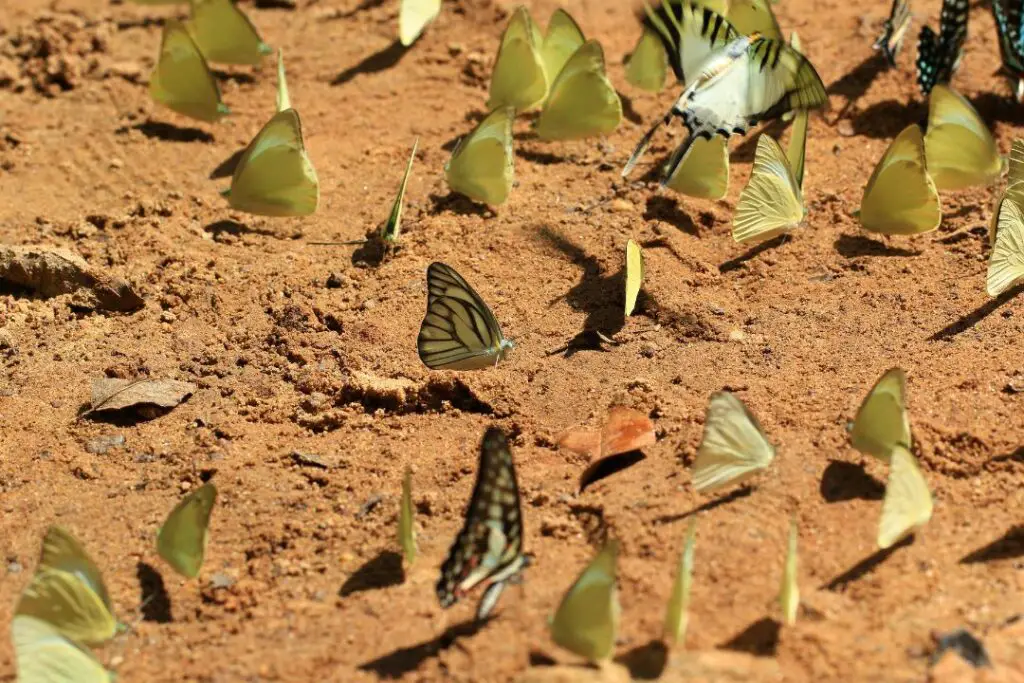
Seasonal Changes In Diet
For butterflies, seasonal changes are a matter of survival and their menu changes along with the calendar.
From salt binges on sizzling days to hibernation hoarding, let’s find out what’s cooking (or not) during different times of the year.
Hot days, sweat, and salt
On sweltering days, butterflies might follow you around, and sadly, it’s not because they like you. It’s for that lovely, salty sweat.
But why salts and minerals? Well, it turns out they’re essential for butterflies to stay healthy:
- Sodium: Critical for nerve and muscle function.
- Calcium: Vital for wing development.
Butterflies land on your sweaty skin or clothes and suck the sweat using their proboscis, like a kid with a juice box. Sometimes, they’ll even go for tears or damp soil to get their mineral fix.
Winter hibernation and changes in diet
When the cold winds blow, most butterflies have two options: “Bye, gotta migrate!” or “See ya in spring; I’m hibernating.”
For some butterflies, winter is chill time. They go dormant, taking refuge in crevices or other shelters. They will feed on nectar from late-blooming plants like buddleia to store fat for the long winter.
But why hunker down when you can hit the skies? Some butterflies seek warmer pastures when winter looms, with the Monarch making a monumental journey to warmer climates.
- Monarch Butterfly: The poster child of migration, travelling up to 3,000 miles.
- Painted Lady: Another long-haul traveller, albeit less famous.
- Red Admiral: Migrates shorter distances but avoids hibernation.
The weather changes, and so does the butterfly’s dining table. It’s adapt or flutter away. Whether they’re slurping your sweat or bedding down for the winter, butterflies are hardwired for survival.

The Changing Diet From Caterpillar To Butterfly
To appreciate the dietary journey of a butterfly, you have to look at the “before” too. It’s a life of transformation, from crawling critters to flying wonders, and their menus adapt accordingly.
*Additional reading – Learn more about one of nature’s most miraculous transformations as a caterpillar transforms into a butterfly.
What do caterpillars feed on?
For caterpillars, the right “birth restaurant,” or host plant, is crucial for survival. This will be where they’re born and a veritable feast for these hungry critters.
Knowing which plants are hosts for which caterpillars can help amateur and expert gardeners cultivate a butterfly-friendly environment. Check out our handy list:
| Host Plant | Caterpillar Guests | Notable Features |
|---|---|---|
| Milkweed | Monarch | It contains toxic cardenolides for defence |
| Parsley | Black Swallowtail | Rich in essential nutrients |
| Oak | Purple Hairstreak | Tannins offer some protection |
| Willow | Comma, Viceroy | Supports multiple species |
| Cherry | Red-Spotted Purple, Tiger Swallowtail | Woodland preference |
| Alfalfa | Orange Sulphur | Common in meadows |
| Dill | Eastern Black Swallowtail | Common in gardens |
| Fennel | Anise Swallowtail | Found in various habitats |
| Clover | Clouded Sulphur | Abundant in fields and meadows |
| Nettle | Red Admiral, Question Mark | Provides stinging protection |
| Passion Vine | Gulf Fritillary | Tropical and subtropical regions |
| Cabbage | Cabbage White | Very common in gardens |
| Bird’s Foot Trefoil | Eastern Tailed Blue | Often found in disturbed areas |
| Citrus | Giant Swallowtail | Citrus groves or backyard trees |
| Snapdragon | Common Buckeye | Prefers full sun |
From crawling munch machines to elegant nectar-sippers, a butterfly’s life is a gastronomic adventure. Check out our read on what caterpillars eat to learn more about their fascinating diets.
In Conclusion
You made it to the finish line! From slurping nectar with built-in straws to surprising you with their love for rotting fruit and sweat, butterflies are not your run-of-the-mill picky eaters.
So go ahead, make your backyard a buffet for butterflies. Turn your patio into a pollinator party. Anything we can do to help these beautiful insects is a win here at Revive a Bee.
Are you looking for more great reads? Learn how bees relieve themselves in our short read on how bees poop!

